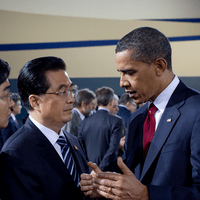BEIJING -- Although nuclear arms control is not likely to be a major agenda item during President Barack Obama's visit to China, it should be. One of the obstacles facing the president as he seeks to realize the ambitious goals endorsed by the Nobel Peace Prize Committee is the need to transform the primarily bilateral strategic arms control relationship inherited from the Cold War into one that places greater emphasis on multilateral frameworks.
Although Moscow and Washington have made progress in negotiating a replacement for the Strategic Arms Reduction Treaty (START) that expires this December, other nuclear weapons states must also join this reduction process, which thus far has been almost exclusively a Russian-American affair.
Obama's decision to relocate U.S. missile defenses away from Russia's western borders has placed the Russian-American dispute on this issue on standby. Yet, achieving a durable solution to their differences in this area may require creating a multinational missile defense architecture, one that embraces Russia, the United States, and other countries in Europe and Asia.

